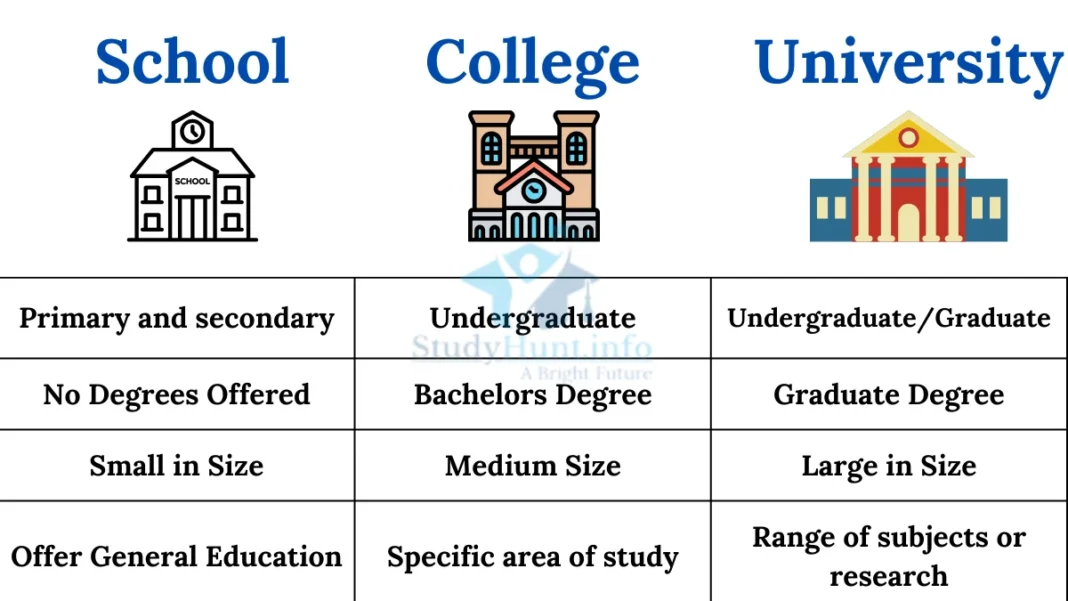Introduction
In the United States, the terms “school,” “college,” and “university” are often used interchangeably, leading to confusion for many individuals, especially international students. However, each term holds a distinct meaning within the American education system, encompassing various levels of academic institutions. In this article, we will delve into the differences between school, college, and university in the USA, clarifying their roles, structures, and educational offerings.
Understanding the distinctions between school, college, and university is essential for navigating the American education system effectively. Each institution plays a unique role in shaping a student’s academic journey, from foundational education in schools to specialized training in colleges and comprehensive higher education experiences in universities. Each of these institution offer scholarship for international students sponsored by either Government, Individual or an NGO like Tide and Downy Back to School Scholarship By Procter & Gamble.
1. School

Interestingly School is a word derived from Greek ‘scholē’ which means Leisure, If you look at the dictionary “School” means “An organization that provides instruction”. A “school” in the United States generally refers to an institution that offers education to students from kindergarten to 12th grade, also known as K-12. These schools are divided into elementary, middle, and high schools. Elementary schools focus on the foundational years of education and typically cover grades 1 to 5 or 6. Middle schools encompass grades 6 to 8 and provide a transitional phase between elementary and high school. High schools cover grades 9 to 12, where students prepare for higher education or vocational paths.
Types of School
In the United States, there are several main types of schools that cater to different age groups, educational needs, and focuses. These types of schools encompass the diverse educational landscape of the country and provide options for students to receive an education tailored to their requirements. The main types of schools in the USA include:
- Public Schools: Public schools are government-funded institutions that offer free education to students within a specific geographic area or school district. They are open to all students regardless of their socioeconomic background, and they follow a standardized curriculum established by the state or district. Public schools provide a wide range of academic and extracurricular programs.
- Private Schools: Private schools are independently funded educational institutions that are not operated by the government. They can vary greatly in terms of their educational philosophies, teaching approaches, and religious affiliations. Private schools often have smaller class sizes, more specialized programs, and greater flexibility in their curriculum compared to public schools. They typically charge tuition fees and may have selective admission processes.
- Charter Schools: Charter schools are publicly funded but operate independently of the traditional public school system. They are granted more autonomy in exchange for meeting specific performance goals outlined in their charter agreements. Charter schools have the freedom to experiment with different teaching methods and curricula. They are open to students from the surrounding area and do not charge tuition.
- Magnet Schools: Magnet schools are public schools that offer specialized programs or curricula designed to attract students with specific interests or talents. These schools often have a thematic focus, such as performing arts, science and technology, or international studies. Students from outside the designated attendance area may apply to attend magnet schools.
- Parochial or Religious Schools: Parochial or religious schools are private schools that are affiliated with a specific religious denomination. These schools often integrate religious teachings and values into their curriculum alongside traditional academic subjects. They cater to families seeking a faith-based education for their children.
- Montessori Schools: Montessori schools follow the teaching philosophy developed by Maria Montessori, which emphasizes hands-on, experiential learning and individualized instruction. These schools often have mixed-age classrooms and focus on nurturing a child’s independence and self-directed learning.
- Boarding Schools: Boarding schools are residential institutions where students live on campus during the school term. They provide a comprehensive educational experience that includes academics, extracurricular activities, and residential life. Boarding schools can offer a rigorous academic curriculum and a wide range of enrichment opportunities.
- Homeschooling: Homeschooling involves parents or guardians taking responsibility for their child’s education at home rather than sending them to a traditional school. Homeschooling families have the flexibility to customize the curriculum and teaching methods to suit their child’s learning style and needs.
Online Courses are now the way forward to share knowledge with interested students without attending any physical classrooms. Free Online Courses from Ivy League Schools With Certificates is a great opportunity for all the students to gain knowledge from the best teachers in the world.
2. College:

College is word derived from Latin word “collegium” which means “”community, society, guild,”. “College” in the American context is often used to describe institutions that offer higher education after completing high school but before obtaining a bachelor’s degree. This phase of education is referred to as “college” or “community college.” Community colleges, also known as junior colleges or two-year colleges, provide a variety of associate degree programs and certificates. These programs often focus on practical skills and provide a more affordable option for students aiming to complete their general education requirements before transferring to a four-year university.
Key characteristics of colleges include:
- Offering associate degrees and certificates in a range of disciplines.
- Focus on practical skills and vocational training.
- More affordable tuition compared to universities.
- Flexible schedules for working students or those with other commitments.
- Often serving as a pathway for transferring to a university.
Types of Colleges
In the United States, higher education is offered by a diverse range of colleges, each catering to different educational goals, academic programs, and student populations. The main types of colleges in the USA include:
- Public colleges: These colleges are funded by the government and are typically more affordable than private colleges. They are open to all students, regardless of their financial background.
- Private colleges: These colleges are not funded by the government and are typically more expensive than public colleges. They often have higher admissions standards and offer more specialized programs.
- For-profit colleges: These colleges are businesses that are operated for profit. They are typically less expensive than private colleges, but they may also have lower quality education.
- Community Colleges: Community colleges, also known as junior colleges or two-year colleges, offer associate degree programs and certificates. They provide a more affordable option for students to complete their general education requirements and gain practical skills before potentially transferring to a four-year university. Community colleges often have open admission policies and offer a variety of vocational and technical programs.
- Liberal Arts Colleges: Liberal arts colleges emphasize a broad-based education that covers a range of disciplines in the arts, humanities, social sciences, and sciences. These colleges typically have smaller class sizes and encourage critical thinking, writing, and communication skills. Liberal arts colleges often award bachelor’s degrees and focus on providing a well-rounded education.
- Technical and Vocational Colleges: Technical and vocational colleges offer specialized training and education in fields such as healthcare, technology, trades, and other career-focused areas. These colleges prepare students for specific careers and provide hands-on training, often leading to certificates, diplomas, or associate degrees.
- Historically Black Colleges and Universities (HBCUs): HBCUs were established to primarily serve the African American community during times of racial segregation. They continue to provide education to a diverse student body and emphasize academic excellence, cultural heritage, and inclusivity.
- Hispanic-Serving Institutions (HSIs), Tribal Colleges, and Minority-Serving Institutions (MSIs): HSIs, tribal colleges, and MSIs serve specific minority populations and are often committed to addressing educational disparities and promoting diversity. These institutions offer unique programs and support services to help underrepresented students succeed.
Remote working now a days are in huge demand many countries are offering Nomad Visa for workers from all around the world. Portugal a part of European Union and Schengen Area is also offering Digital Nomad Visa.
3. University:

Word “University” is originally derived from the Latin ‘universitas magistrorum et scholarium’ which in English means “community of teachers and scholars”. A “university” in the United States is an institution that provides a diverse array of undergraduate, graduate, and sometimes doctoral degree programs. Universities offer a comprehensive educational experience that combines academic, research, and extracurricular activities. They are typically larger and more diverse than colleges, housing multiple schools or colleges within the university structure, each specializing in different disciplines.
Key characteristics of universities include:
- Offering bachelor’s, master’s, and doctoral degrees.
- Conducting significant research in various fields.
- Housing specialized schools or colleges, such as the College of Arts and Sciences, School of Business, School of Engineering, etc.
- Providing a wide range of extracurricular activities, including clubs, sports, and cultural events.
- Often having more extensive campus facilities and resources.
Types of Universities
There are also different types of Universities in USA such as,
Public Universities:
Public universities are funded by state governments and offer a wide range of academic programs at both the undergraduate and graduate levels. They often have larger student populations and may consist of multiple campuses. Public universities typically offer in-state tuition rates for residents of the state where the university is located, and higher tuition rates for out-of-state students.
Private Universities:
Private universities are independently funded institutions that offer a variety of academic programs. They can range in size from small colleges to large research universities. Private universities often have more flexible curricula and may provide more personalized attention due to smaller class sizes. They usually charge higher tuition rates compared to public universities.
Research Universities:
Technical and vocational colleges offer specialized training and education in fields such as healthcare, technology, trades, and other career-focused areas. These colleges prepare students for specific careers and provide hands-on training, often leading to certificates, diplomas, or associate degrees.
Students from all around the world can take Harvard University Free Online Courses without any expenses and study from one of the best faculty in the world.
Key Differences
Here is a table summarizing the key differences between school, college, and university in the USA:
| Feature | School | College | University |
|---|---|---|---|
| Level of education | Primary and secondary | Undergraduate | Undergraduate and graduate |
| Degrees offered | None | Bachelor’s degree | Bachelor’s degree and graduate degrees |
| Size | Varies | Varies | Can be large or small |
| Type | Public or private | Public or private | Public or private |
| Focus | General education | Specific area of study | Broad range of subjects or research |
Ultimately, the best choice for you will depend on your individual needs and goals. If you are not sure what you want to study, or if you want to get a general education, then a school may be a good option for you. If you know what you want to study and you want to get a bachelor’s degree, then a college may be a good option for you. And if you want to get a graduate degree or conduct research, then a university may be a good option for you.
Which to Choose?
Choosing between a school, college, or university in the USA depends on several factors, including your academic goals, career aspirations, personal preferences, and current educational level. Here’s a step-by-step guide to help you make an informed decision:
1. Define Your Goals: Consider your long-term goals. Are you looking for a high school education, a two-year associate degree, a four-year bachelor’s degree, or advanced degrees like master’s or doctoral programs? Your goals will influence whether you should attend a school, college, or university.
2. Identify Your Interests: Think about your academic interests and the subjects you enjoy learning about. Different institutions might specialize in various fields, so choose an institution that offers programs aligned with your passions.
3. Assess Your Academic Preparedness: Evaluate your academic achievements and strengths. If you’re still in high school, consider your performance in various subjects. If you’re considering college or university, think about whether you need to start with an associate degree or if you’re ready for a bachelor’s program.
4. Consider Location: Think about whether you prefer studying close to home or are open to relocating. Different regions might have different schools, colleges, and universities that offer various programs.
5. Research Institutions: Start researching schools, colleges, and universities that offer programs that interest you. Look into their reputation, faculty, available resources, campus facilities, extracurricular activities, and student support services.
6. Review Program Offerings: Explore the academic programs offered by each institution. Ensure they provide the courses and majors that align with your interests and goals. Consider the curriculum, available specializations, and any unique opportunities like internships, research, or study abroad.
7. Consider Financial Factors: Evaluate the tuition and fees of the institutions you’re considering. Compare the costs of different options and consider whether you qualify for financial aid, scholarships, or grants. Consider your budget and how you plan to finance your education.
8. Size and Atmosphere: Consider whether you prefer a smaller, more intimate learning environment or a larger campus with diverse offerings. Different institutions have varying campus sizes and atmospheres that can impact your overall experience.
9. Visit Campuses (if possible): If feasible, visit the campuses you’re interested in. This will give you a sense of the environment, facilities, and campus life. Meeting with faculty and students can help you gain insights into the institution’s culture.
10. Seek Guidance: Talk to teachers, counselors, parents, mentors, or current students for advice. They can offer valuable perspectives and insights that might help you make your decision.
11. Consider Transfer Options: If you’re unsure about committing to a university from the start, consider starting at a community college to complete general education requirements. This can save you money and give you time to explore your options before transferring to a four-year institution.
12. Trust Your Instincts: Ultimately, trust your instincts. Choose the institution that aligns best with your academic and personal goals, as well as the environment where you feel you will thrive.
Remember that your educational journey is unique, and the choice you make should reflect your aspirations and preferences. Take your time to research and consider all your options before making a decision.
Conclusion
Selecting the right educational path among schools, colleges, and universities in the USA is a pivotal decision that shapes your academic and career trajectory. By defining your goals, interests, and strengths, you can determine whether a school, community college, liberal arts college, university, or other specialized institution aligns with your aspirations. Thorough research into program offerings, location, financial considerations, and campus atmosphere is essential for making an informed choice. Seeking advice from trusted sources, visiting campuses, and evaluating transfer options can further refine your decision-making process. Remember that your educational journey is unique, and by carefully considering these factors, you can confidently embark on a path that aligns with your ambitions and paves the way for a successful future.

